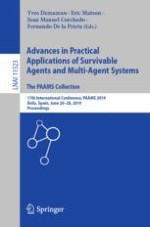2019 | Buch
Advances in Practical Applications of Survivable Agents and Multi-Agent Systems: The PAAMS Collection
17th International Conference, PAAMS 2019, Ávila, Spain, June 26–28, 2019, Proceedings
herausgegeben von: Yves Demazeau, Eric Matson, Juan Manuel Corchado, Dr. Fernando De la Prieta
Verlag: Springer International Publishing
Buchreihe : Lecture Notes in Computer Science
